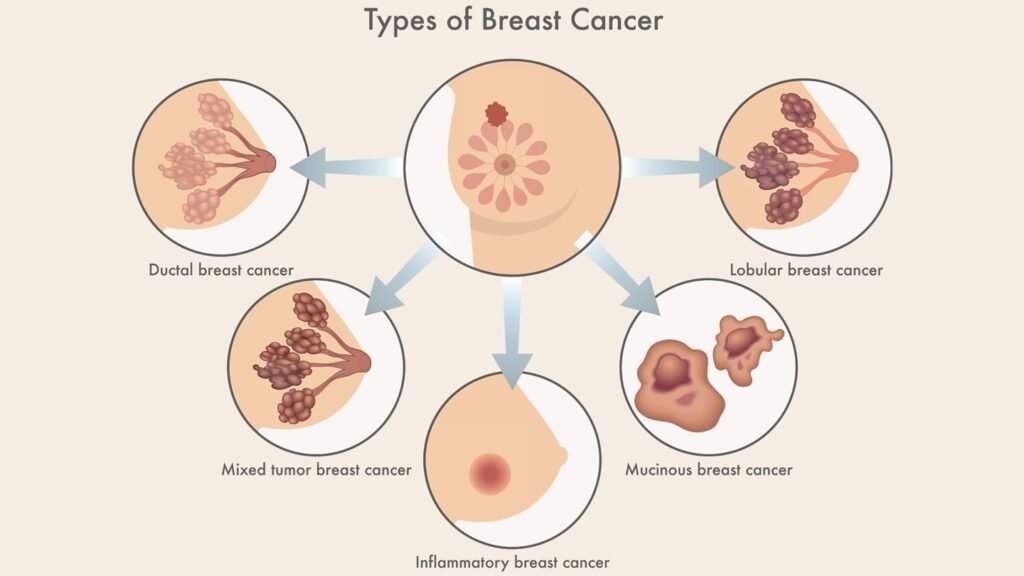
Breast Cancer
Introduction: breast cancer occurs when healthy cells of the breast start to grow abnormally. Signs of breast cancer are:
â— A lump in the breast.
â— Change of breast shape
â— Dimpling of skin
â— Fluid coming from the nipple â— Red or scaly patches
About 5 to 10 per cent of cases are the results of genetic predisposition, from a person’s parents or 1st relation including BRCA1 and BRCA2.
Breast cancer mostly develops in cells from the lining of milk ducts and the lobules that supply these ducts with milk.
Due to excessive cell growth in breast tissues, it can spread to other organs such as the lungs, liver or may be localized to breast tissue according to grades and stage. Breast cancer is the most common cancer in females, mostly occurs above 40 years and rarely occurs in men.
Breast cancer can begin in different parts of the breast is made up of 3 parts:
â— Lobules are the glands that produce milk.
â— Ducts are the tubes that carry milk to the nipples. â— Connective tissues hold everything together.
Most breast cancer begins in the ducts and lobules. Types:
1. Ductal carcinoma in situ: it is the most common type of non-invasive breast cancer. Non-invasive means that it spreads beyond the ducts into surrounding breast tissue.
Lobular carcinoma in situ: this cancer begins in the glands of the breast that produce breast milk. It is in the rarest condition. it is not cancer but diagnosed with lobular carcinoma in situ have an increased risk of developing breast cancer.
invasive/infiltrating ductal carcinoma: abnormal growth of cells usually begins in the duct. It invades the fatty tissue of the breast. Invasive carcinoma metastasized via bloodroot or lymphatic root.
Invasive lobular carcinoma: it is the second most common type of breast cancer. Invasive cancer means that cancer cells can break down the lobules and spread via lymph nodes to other body organs.
Paget’s disease of the nipple: it starts in the breast ducts, spread to the nipple surface and areola. Eczema type rashes like crusty flakes and discharge that may irritate.
Causes and risk factors:
Family history: first degree relatives of women who have been diagnosed with breast cancer are prone to develop cancer.
Genetic mutations of BRCA1 and BRCA2 genes are prone to develop cancer.
Age: The risk factors of breast cancer increase with age extremely rare in teenagers and below the age of 20.
Hormonal factors.
Obesity and dietary factors.
Oral contraceptive or hormonal replacement therapy.
Dietary:
â— excessive intake of fats â— Alcohol consumption
â— Iodine deficiency.
â— Smoking, etc. Symptoms:
Lumps in the breast that are painful.
Lumps can be felt in the roots of lymph nodes mainly in
the armpits. During the physical examination of the breast,
it can be felt with fingertips.
Changes in the shape of the breast, like the orange like
the appearance of the breast with inverted nipples.
Swelling of the breast.
Discharge from nipples that can be offensive.
Stony hardness of breast in an advanced stage of breast
cancer.
Tenderness Of breast or constant pain in affected breast
and armpits.
In advanced stages :
â— Weight loss can occur.
â— Loss of appetite.
â— Severe pain with burning or tingling sensation of the
breast. Diagnosis:
â— Physical examination: inspection: first of all see if there is any sign of inflammation in the breast.
palpation: patients should lie down arm overhead. palpate the breast using fingertips in a circular motion from the axilla to the bra line to rule out if there is an abnormal growth in the breast.
â— Mammography: it is an x-ray of the breast. It is used in the early stages of breast cancer.
â— Fine needle aspiration: it is a type of biopsy where a needle is inserted into the lump to collect the cells to look for cancerous growth.
â— Ultrasonography of breasts
â— Biopsy.
Prevention:
Breast cancer can be prevented by implementing good habits like:
â— A proper healthy nutritional diet should be taken.
â— Stop consumption of alcohol and smoking.
â— Breastfeeding should be done for at least more than a
year to reduce the risk of developing cancer.
â— Maintain a healthy weight. Obese women are more prone
to develop cancer.
â— Do exercise regularly for 20-30 minutes.
â— Don’t take hormonal therapy because it increases the risk
of developing cancer.
â— Reduce anxiety and stress.
Homoeopathy treatment: homoeopathy medicine for breast cancer is safe and most reliable for the mental and physical health of patients. With the help of homoeopathy treatment the immune system boosts up and it can prevent further side effects of chemotherapy and radiotherapy.
Homoeopathic medicines relieve symptoms like burning sensation, redness, pain, and control the growth of cancerous cells and reduce the size of the lump. It helps in improvising the appetite.